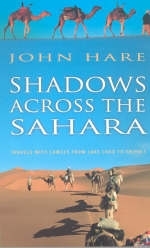
Shadows Across the Sahara
With Camels from Tripoli to Lake Chad
Seiten
2003
Constable (Verlag)
978-1-84119-626-8 (ISBN)
Constable (Verlag)
978-1-84119-626-8 (ISBN)
- Keine Verlagsinformationen verfügbar
- Artikel merken
A tale of man and beast overcoming formidable odds. John Hare set out from the shores of Lake Chad with 25 camels, four Tuaregs, a Chinese professor, a white Kenyan rancher and an Englishman. His objective was to reach Tripoli and the expedition took three and a half months to cover 1462 miles.
Riding Pasha, his beloved white camel, John Hare set out from the shrinking shores of Lake Chad with 25 camels, 4 Tuaregs, a Chinese professor, a white Kenyan rancher and a young Englishman. His objective: to reach Tripoli, following an ancient camel route, notorious in the days of slavery as a road of extreme hardship and death and last crossed in its entirety by Hanns Vischer in 1906. Today the ancient slaving route is strewn, not, as formerly, with the bones of deal slaves, but with over one thousand carcasses of dead camels. The expedition took three and a half months to cover 1462 miles and along the way met every kind of person: village market stall-holders, incredulous border officials and owners of travelling camel salt caravans. They encountered descendants of people who had met and entertained Hanns Vischer and introduced the Tuaregs to the powers of acupuncture and the ancient art of Tai Chi. However, the true heroes of this journey were John Hare's camels - resolute and uncomplaining in both hot and freezing conditions and sometimes in the face of icy winds. Two of the camels died of exhaustion, but the rest eventually reached journey's end.
Riding Pasha, his beloved white camel, John Hare set out from the shrinking shores of Lake Chad with 25 camels, 4 Tuaregs, a Chinese professor, a white Kenyan rancher and a young Englishman. His objective: to reach Tripoli, following an ancient camel route, notorious in the days of slavery as a road of extreme hardship and death and last crossed in its entirety by Hanns Vischer in 1906. Today the ancient slaving route is strewn, not, as formerly, with the bones of deal slaves, but with over one thousand carcasses of dead camels. The expedition took three and a half months to cover 1462 miles and along the way met every kind of person: village market stall-holders, incredulous border officials and owners of travelling camel salt caravans. They encountered descendants of people who had met and entertained Hanns Vischer and introduced the Tuaregs to the powers of acupuncture and the ancient art of Tai Chi. However, the true heroes of this journey were John Hare's camels - resolute and uncomplaining in both hot and freezing conditions and sometimes in the face of icy winds. Two of the camels died of exhaustion, but the rest eventually reached journey's end.
John Hare, the last recruit into the British colonial administration in northern Nigeria, worked in remote areas on the Cameroon/Nigeria border and later with the UN in Kenya. Deeply concerned for the endangered wild Bactrian camel in China and Mongolia he was involved in setting up one of the largest nature reserves in the world. He is the author of The Lost Camels of Tartary about his wild camel expeditions in Central Asia, and over 30 books for children.
| Erscheint lt. Verlag | 6.6.2003 |
|---|---|
| Zusatzinfo | illustrations, maps |
| Verlagsort | London |
| Sprache | englisch |
| Maße | 153 x 234 mm |
| Gewicht | 570 g |
| Themenwelt | Reisen ► Reiseberichte ► Afrika |
| ISBN-10 | 1-84119-626-6 / 1841196266 |
| ISBN-13 | 978-1-84119-626-8 / 9781841196268 |
| Zustand | Neuware |
| Haben Sie eine Frage zum Produkt? |
Mehr entdecken
aus dem Bereich
aus dem Bereich
unsere Reise als Freiwilligenhelfer in Südafrika
Buch | Softcover (2024)
Conbook Medien (Verlag)
CHF 25,90


